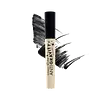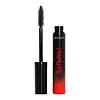What's inside
What's inside
 Key Ingredients
Key Ingredients

No key ingredients
 Benefits
Benefits

 Concerns
Concerns

 Ingredients Side-by-side
Ingredients Side-by-side

Water
Skin ConditioningCopernicia Cerifera Wax
Glyceryl Stearate
EmollientHydrogenated Olive Oil Stearyl Esters
Emulsion StabilisingHydroxypropyl Starch
Synthetic Wax
AbrasiveStearic Acid
CleansingHelianthus Annuus Seed Wax
Skin ConditioningPalmitic Acid
EmollientButylene Glycol
HumectantOlea Europaea Oil Unsaponifiables
Skin ConditioningAminomethyl Propanol
BufferingRicinus Communis Seed Oil
MaskingSynthetic Beeswax
Emulsion StabilisingPhenoxyethanol
PreservativeCaprylyl Glycol
EmollientGalactoarabinan
Rhus Succedanea Fruit Wax
Shorea Robusta Resin
TonicHydroxyethylcellulose
Emulsion StabilisingSodium Dehydroacetate
PreservativeXanthan Gum
EmulsifyingHydroxyacetophenone
AntioxidantTocopherol
AntioxidantCI 77499
Cosmetic ColorantUltramarines
Water, Copernicia Cerifera Wax, Glyceryl Stearate, Hydrogenated Olive Oil Stearyl Esters, Hydroxypropyl Starch, Synthetic Wax, Stearic Acid, Helianthus Annuus Seed Wax, Palmitic Acid, Butylene Glycol, Olea Europaea Oil Unsaponifiables, Aminomethyl Propanol, Ricinus Communis Seed Oil, Synthetic Beeswax, Phenoxyethanol, Caprylyl Glycol, Galactoarabinan, Rhus Succedanea Fruit Wax, Shorea Robusta Resin, Hydroxyethylcellulose, Sodium Dehydroacetate, Xanthan Gum, Hydroxyacetophenone, Tocopherol, CI 77499, Ultramarines
Water
Skin ConditioningParaffin
PerfumingGlyceryl Stearate
EmollientSynthetic Beeswax
Emulsion StabilisingStearic Acid
CleansingButylene Glycol
HumectantAcacia Senegal Gum
MaskingPalmitic Acid
EmollientPolybutene
Oryza Sativa Bran Wax
Skin ConditioningMica
Cosmetic ColorantVp/Eicosene Copolymer
Ozokerite
Emulsion StabilisingAminomethyl Propanol
BufferingHydrogenated Vegetable Oil
EmollientHydroxyethylcellulose
Emulsion StabilisingStearyl Stearate
EmollientTropolone
Skin ConditioningEthylhexylglycerin
Skin ConditioningPhenoxyethanol
PreservativeIron Oxides
Water, Paraffin, Glyceryl Stearate, Synthetic Beeswax, Stearic Acid, Butylene Glycol, Acacia Senegal Gum, Palmitic Acid, Polybutene, Oryza Sativa Bran Wax, Mica, Vp/Eicosene Copolymer, Ozokerite, Aminomethyl Propanol, Hydrogenated Vegetable Oil, Hydroxyethylcellulose, Stearyl Stearate, Tropolone, Ethylhexylglycerin, Phenoxyethanol, Iron Oxides
Ingredients Explained
These ingredients are found in both products.
Ingredients higher up in an ingredient list are typically present in a larger amount.
Aminomethyl Propanol is used to adjust the pH of products. It is also used as a base to create other organic compounds. Having a balanced pH is important for protecting your skin.
Aminomethyl propanol is safe to use in cosmetics up to 1%. It is soluble in water.
Butylene Glycol (or BG) is used within cosmetic products for a few different reasons:
Overall, Butylene Glycol is a safe and well-rounded ingredient that works well with other ingredients.
Though this ingredient works well with most skin types, some people with sensitive skin may experience a reaction such as allergic rashes, closed comedones, or itchiness.
Learn more about Butylene GlycolGlyceryl Stearate is a mix of glycerin and stearic acid.
It is used to stabilize the mixing of water and oil ingredients. By preventing these ingredients from separating, it can help elongate shelf life. It can also help thicken the product's texture.
As an emollient, it helps soften skin and supports barrier-replenishing ingredients.
In cosmetics, Glyceryl Stearate is often made from vegetable oils or synthetically produced.
This ingredient may not be fungal-acne safe
Fun fact: The human body also creates Glyceryl Stearate naturally.
Learn more about Glyceryl StearateHydroxyethylcellulose is used to improve the texture of products. It is created from a chemical reaction involving ethylene oxide and alkali-cellulose. Cellulose is a sugar found in plant cell walls and help give plants structure.
This ingredient helps stabilize products by preventing ingredients from separating. It can also help thicken the texture of a product.
This ingredient can also be found in pill medicines to help our bodies digest other ingredients.
Learn more about HydroxyethylcellulosePalmitic Acid is a fatty acid naturally found in our skin and in many plant and animal sources. In cosmetics, it is usually derived from palm oil. It serves many purposes in skincare, acting as a cleanser, emollient, and emulsifier.
As an emollient, palmitic acid helps soften and smooth the skin by preventing water loss. In cleansers, it helps remove oil and dirt while creating foam.
Its emulsifying properties help stabilize products by keeping water and oil-based ingredients from separating.
This may not be suitable for fungal acne-prone skin, as fatty acids like this can sometimes trigger breakouts in sensitive individuals.
Learn more about Palmitic AcidPhenoxyethanol is a preservative that has germicide, antimicrobial, and aromatic properties. Studies show that phenoxyethanol can prevent microbial growth. By itself, it has a scent that is similar to that of a rose.
It's often used in formulations along with Caprylyl Glycol to preserve the shelf life of products.
Stearic Acid is a fatty acid. It is an emollient, emulsifier, and texture enhancer.
As an emollient, stearic acid helps soften skin. It aids the skin's protective barrier by preventing water loss. It also provides a gentle cleansing effect without stripping away natural oils.
Stearic acid may also be used to enhance the texture of products. It can add volume and stabilize ingredients such as water and oil. This can help water and oil ingredients from separating.
Sources of stearic acid include animal or vegetable fats/oils such as coconut or shea. It can be naturally found in butter, cocoa butter, shea butter, vegetable fats, and animal tallow.
This ingredient may not be Malassezia folliculitis, or fungal-acne safe.
Learn more about Stearic AcidSynthetic beeswax is created to be identical in structure to beeswax. It possesses the same occlusive and emulsion properties.
A blend of fatty acid esters, fatty acids, and alcohols are used to create synthetic beeswax. Whether or not this ingredient is vegan depends on the source. Sometimes, lanolin is used for its creation.
This ingredient may not be Malassezia folliculitis, or fungal-acne safe.
Learn more about Synthetic BeeswaxWater. It's the most common cosmetic ingredient of all. You'll usually see it at the top of ingredient lists, meaning that it makes up the largest part of the product.
So why is it so popular? Water most often acts as a solvent - this means that it helps dissolve other ingredients into the formulation.
You'll also recognize water as that liquid we all need to stay alive. If you see this, drink a glass of water. Stay hydrated!
Learn more about Water